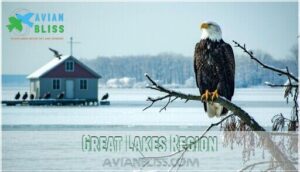This site is supported by our readers. We may earn a commission, at no cost to you, if you purchase through links.

Instead, you’ll find these powerful raptors staying active year-round through remarkable survival strategies. Eagles maintain constant activity levels, using migration patterns to follow food sources and avoid harsh conditions.
Their specialized feathers provide exceptional insulation, while behavioral adaptations like communal roosting help conserve energy. Some eagles migrate south to warmer regions, while others remain in northern territories if open water and prey remain available.
Rather than entering dormancy like bears or groundhogs, eagles rely on their superior hunting skills and physical adaptations to thrive during winter months. Their winter survival secrets reveal fascinating insights about nature’s most efficient predators, showcasing their ability to stay active through constant activity levels.
Table Of Contents
- Key Takeaways
- Do Eagles Hibernate in The Winter?
- Do Eagles Hibernate in Winter?
- Where Do Eagles Go During Winter?
- When Do Eagles Migrate?
- Why Do Eagles Have Babies in Winter?
- How Do Eagles Survive Winter?
- Do All Eagles Migrate?
- Where Do Eagles Migrate to in Winter?
- Do Eagles Stay Active During Winter?
- How Far Do Eagles Migrate?
- When Do Eagles Migrate North?
- Frequently Asked Questions (FAQs)
- Do bald eagles hibernate?
- Can eagles survive winter?
- Where do bald eagles winter?
- Do eagles migrate in the winter?
- Why is winter important for Eagles?
- What distinguishes Eagles from hibernating animals?
- Can eagles survive cold weather?
- What happens to eagles in the winter?
- Do eagles stay active during winter?
- How do eagles survive winter?
- Conclusion
Key Takeaways
- You won’t find eagles hibernating – these powerful raptors stay active year-round, using thick feather insulation and behavioral adaptations instead of entering dormancy like bears or groundhogs.
- They migrate strategically when needed – northern eagles travel south when water sources freeze, while coastal populations often remain residents since they’ve got consistent access to open water and food.
- Winter becomes their breeding season – eagles lay eggs in February during harsh conditions, timing it perfectly so chicks hatch when fish populations peak in spring for maximum survival rates.
- They’re master winter survivors – eagles use communal roosting for warmth, switch from hunting to scavenging roadkill, and maintain specialized heat-exchange systems to prevent frostbite in extreme cold.
Do Eagles Hibernate in The Winter?
Do eagles hibernate in winter? The answer might surprise you. Eagles don’t hibernate at all.
Instead, these powerful raptors stay active throughout the coldest months, relying on remarkable adaptations for survival. Their eagle winter survival strategy centers on energy conservation through smart behavioral changes rather than dormancy.
Eagles develop incredible feather insulation, growing dense underfeathers that trap warm air close to their bodies. This natural down creates multiple layers for superior cold tolerance.
Eagles craft nature’s ultimate winter coat – dense underfeathers that trap warm air in multiple insulating layers.
Their roosting behavior changes dramatically – they’ll huddle together in sheltered areas near food sources, sharing body heat while conserving energy. Thermoregulation becomes vital during harsh weather.
Eagles can fluff their feathers to create air pockets, basically wearing a built-in winter coat. When temperatures drop severely, they’ll reduce activity levels but never enter true hibernation like bears or groundhogs.
Understanding eagles in winter reveals these magnificent birds are perfectly equipped to thrive year-round.
Do Eagles Hibernate in Winter?
You might think eagles hibernate like bears, but they don’t sleep through winter at all.
Instead, these powerful birds stay active year-round, using clever survival strategies to handle the cold months.
Constant Activity
Unlike many animals that slow down for winter, eagles winter behavior shows remarkable constant vigilance and daily activity.
These powerful raptors maintain their behavioral patterns year-round, though they adjust their strategies.
Eagle winter activity includes increased scavenging at communal feeding sites, where hunting frequency shifts from active predation to opportunistic feeding.
Their energetic demands require continuous movement between roosts and food sources, proving how eagles survive winter through adaptation rather than dormancy.
Migratory Behavior
Rather than hibernating, these powerful birds engage in complex migratory patterns driven by specific migration triggers like frozen water sources.
Their juvenile dispersal patterns differ substantially from adults, with young eagles traveling greater distances.
Their wind dependence determines their daily distance – up to 225 miles with favorable conditions.
Their seasonal movement to wintering grounds demonstrates remarkable adaptation, with return timing perfectly synchronized to breeding needs.
Adaptation to Cold Weather
Rather than entering dormancy, bald eagles showcase impressive winter survival strategies through specialized adaptations. Their feather insulation provides vital protection, while heat regulation mechanisms prevent frostbite through counter-current exchange systems.
These remarkable birds employ three key survival methods:
- Building fat reserves during fall months for energy storage
- Engaging in communal roosting to share body heat efficiently
- Adjusting feeding behaviors to maximize caloric intake
These eagle adaptations demonstrate how environmental adaptation enables year-round activity in harsh climates, showcasing their ability to thrive through specialized adaptations.
Highly Specialized Predators
These aerial hunters excel as winter predators, shifting from active hunting to opportunistic scavenging when prey becomes scarce.
Their survival strategies include exploiting carrion, roadkill, and ice-trapped animals while maintaining their predatory instincts.
| Hunting Techniques | Winter Adaptations | Prey Selection |
|---|---|---|
| Active fishing in open water | Increased scavenging behavior | Fish from unfrozen lakes |
| Soaring for thermal efficiency | Communal roosting sites | Roadkill and carrion |
| Opportunistic ground hunting | Reduced energy expenditure | Ice-trapped animals |
| Group feeding coordination | Information sharing networks | Waterfowl near open water |
| Dawn and dusk activity peaks | Fat reserve conservation | Small mammals and birds |
Territorial Defense
Winter doesn’t stop eagles from defending their turf with fierce determination.
These powerful birds maintain strict territorial boundaries even during harsh conditions, proving that eagle winter behavior remains remarkably active and strategic.
- Boundary Marking – Adult pairs patrol and mark their nesting territories year-round
- Intruder Response – Quick, aggressive reactions to any territorial violations occur daily
- Resource Defense – Prime fishing spots and roosting areas get zealously protected
- Mate Guarding – Breeding pairs stick together, ensuring winter territories stay secure
Where Do Eagles Go During Winter?
When winter arrives, you might wonder where these magnificent birds disappear to during the harsh months.
The answer depends on where they live and whether their local water sources freeze over.
Southern United States
During winter months, bald eagles flock to the southern United States seeking open water and abundant food sources.
The lower Mississippi Valley and Chesapeake Bay region become eagle magnets, supporting hundreds of birds along river corridors.
These areas offer stable winter food sources in rivers and reservoirs, attracting both migrant and local Eagle Population populations for ideal survival.
Eagles rely on familiar cues such as coastlines to guide them.
Pacific Northwest
While many eagles migrate south, the Pacific Northwest supports thriving wintering eagles year-round thanks to coastal habitats and abundant prey availability.
Salmon spawning in river systems like the Squamish creates perfect eagle winter habitat.
These eagle adaptations winter strategies help inland populations access reliable food sources, making eagles cold weather survival highly successful in this region.
Alaska
Alaska’s eagles showcase remarkable winter survival strategies despite harsh conditions.
Many migrate south to escape frozen habitats, while coastal populations remain year-round near ice-free waters. These adaptable raptors demonstrate incredible resilience in their northern wintering grounds.
Here’s how Alaska’s eagles master winter survival:
- Coastal concentrations – Eagles cluster near unfrozen shorelines where salmon and marine life remain accessible
- Interior migrations – Inland populations travel vast distances to reach milder coastal or southern locations
- Habitat flexibility – Birds shift from interior territories to maritime environments as winter advances
Food accessibility drives population density patterns across Alaskan habitats, with eagles cold weather adaptations allowing survival in extreme conditions where other species cannot.
Great Lakes Region
The Great Lakes region serves as a critical winter sanctuary for bald eagles seeking open water and abundant food sources.
You’ll spot these magnificent birds congregating along coastal habitats where ice fishing opportunities and unfrozen shorelines provide reliable meals.
The region’s strategic location along major migration routes guarantees steady food availability through winter months.
Population density here reflects successful eagle population recovery, with bald eagle winter survival rates improving dramatically.
These Great Lakes region waters support thriving eagle communities, proving winter survival doesn’t require southern migrations when local resources remain accessible.
Mississippi River Valley
Because the Upper Mississippi River remains ice-free year-round, you’ll find massive eagle winter gatherings here.
This corridor supports hundreds of eagles seeking reliable food availability and protected river habitats.
- Eagle population peaks near dam sites where open water guarantees fish access
- Winter migration brings eagles nearly 900 miles from northern breeding grounds
- Eagle feeding habits winter around confluences where tributaries meet the main river
- Conservation efforts protect roosting forests within eight miles of feeding areas
When Do Eagles Migrate?
You won’t find eagles hibernating in their nests when winter arrives—they stay active and alert throughout the coldest months.
Migration timing varies dramatically depending on where eagles live, with northern populations heading south between August and January when their food sources freeze over, illustrating a key aspect of their survival strategy, such as migration.
Migration Patterns
Eagle migration patterns follow specific environmental triggers rather than calendar dates.
When ice covers northern lakes and rivers, inland migration begins as eagles seek open water sources.
Coastal populations often remain year-round due to consistent food access, while northern birds travel impressive distances.
Golden eagles, for example, exhibit varied behaviors where some western populations are year-round residents, but all eastern populations are migratory, as detailed in this migration pattern overview.
| Migration Factor | Northern Eagles | Coastal Eagles | Juvenile Eagles |
|---|---|---|---|
| Trigger | Ice formation | Food scarcity | Instinctual wandering |
| Distance | Up to 1,000+ km | Minimal movement | Greatest distances |
| Timing | Late fall/winter | Variable | Earlier departure |
| Wind Dependence | High reliance | Moderate | Learning process |
Wind dependence shapes these winter migration patterns substantially.
Eagles won’t fly without favorable thermal currents, averaging 100 miles daily but reaching 225 miles with strong winds.
Migration routes follow major waterways where thermals are reliable.
Unlike flocking birds, eagles migrate alone, creating scattered bird migration streams across vast territories.
Animal migration timing guarantees eagles reach unfrozen waters before starvation threatens survival.
Juvenile Bald Eagle Migration
When do juvenile eagles begin their epic winter migration patterns? These young adventurers leave their natal areas between mid-September and early October, setting out on unpredictable journeys that differ dramatically from adults.
Juvenile eagles demonstrate remarkable dispersal patterns, often wandering extensively and taking indirect migration routes while learning migration behaviors.
- First year survival depends heavily on successful habitat selection during these critical winter months
Unlike adults who return to familiar territories, juveniles may travel much greater migration distances, sometimes taking long stopovers lasting several weeks before continuing their journey.
Northern Adult Migration
When winter approaches, northern adult eagles begin their fall migration as ice covers lakes and rivers.
These migration triggers force them toward coastal areas with open water. Unlike juveniles, adults take direct routes to reclaim breeding grounds quickly.
They can travel up to 225 miles daily with favorable winds, though wind dependence affects their journey timing.
Most return to northern territories by late March, which marks the end of their migration period, influenced by breeding grounds.
Coastal and Temperate Area Eagles
Unlike their northern counterparts, coastal and temperate area eagles often become resident eagles, staying put year-round.
These smart birds don’t need to migrate because they’ve mastered their local habitat preference and food availability patterns.
Here’s what keeps these eagles grounded:
- Consistent open water access – coastal habitats never freeze completely
- Reliable food sources – fish populations remain accessible throughout winter
- Reduced energy costs – no migration means more energy for nesting success
- Established eagle winter roosting sites – familiar territories provide safety
Human impact on eagle winter range remains minimal in these protected coastal areas, allowing populations to thrive without seasonal relocation stress.
Why Do Eagles Have Babies in Winter?
You might wonder why bald eagles choose the harshest season to start their families.
The timing isn’t coincidence – it’s a brilliant survival strategy that guarantees their chicks hatch when food becomes most abundant in spring.
Winter Nesting Advantages
Why do eagles choose winter for breeding? This timing maximizes food abundance when eaglets fledge in spring.
Winter nesting provides heat conservation advantages, as maintaining egg warmth proves easier than cooling in summer heat.
Regional climate adaptations guarantee reduced competition for nesting sites and breeding habitats, and eagle nesting winter strategies align perfectly with peak fish availability during eaglet fledging season, giving chicks superior survival chances.
Egg Laying
Bald eagles start their clutch size of 1-3 eggs during late winter, typically February through March.
Females lay these eggs over egg intervals of 3-6 days rather than consecutively. This timing guarantees eaglets hatch when fish populations peak in spring.
Breeding habitats are carefully selected months earlier, with nesting sites prepared through fall. The breeding schedule varies geographically—southern eagles begin in October while northern populations wait until late January.
This strategic eagle nesting winter timing maximizes hatching success for the next generation. Eagles also roll their eggs to facilitate proper embryo development.
Egg Incubation
Once eggs are laid, the incubation period begins lasting 34-36 days.
Both parents share parental roles, developing a brood patch by losing feathers to transfer heat directly.
They maintain egg temperature at 105°F through careful exchanges every few hours.
This shared parental care guarantees superior egg development and hatching success despite winter’s harsh conditions, with specialized breeding habits adapted for cold climates.
Egg Turning
Once incubation begins, you’ll notice eagle parents carefully rotate their eggs using beaks and feet approximately every hour.
This turning frequency prevents embryo adhesion to shell membranes while ensuring warming consistency across the entire egg surface.
Both parental roles include this critical egg turning behavior during incubation period shifts.
The careful rotation promotes healthy gas exchange and supports ideal development, directly impacting hatching success rates.
These dedicated breeding habits showcase remarkable parental care throughout winter’s harsh conditions.
How Do Eagles Survive Winter?
You might wonder how these powerful raptors handle freezing temperatures and snow-covered landscapes. Eagles don’t hibernate but instead use remarkable physical and behavioral adaptations to thrive during winter months.
Winter Behavior
Throughout winter months, eagles modify their daily routines to maximize survival chances.
You’ll notice dramatic changes in their feeding patterns and social behaviors during cold weather.
Key winter behavior adaptations include:
- Communal roosting – Eagles gather in groups of 50-60 birds near food sources, sharing body heat and information about feeding locations
- Energy conservation – Reduced activity during subzero temperatures, choosing sheltered perches protected from wind
- Dietary flexibility – Increased scavenging of roadkill, frozen carcasses, and discarded fish rather than active hunting
- Group foraging – Following successful hunters and cooperative feeding at reliable food sites
- Strategic movement – Daily activity spikes during clear, warmer days while remaining inactive during storms
These survival strategies demonstrate eagles’ remarkable behavioral adaptability to harsh winter conditions.
Physical Adaptations
Eagles don’t hibernate—they’ve mastered winter survival through remarkable physical adaptations.
Their double-layered feather system creates superior insulation, while counter-current heat exchange prevents frostbite in extremities.
These size variations and heat conservation strategies enable survival in temperatures reaching -25°F.
Many seek superior feather insulation for various purposes.
| Adaptation Type | Mechanism | Benefit |
|---|---|---|
| Feather Insulation | Double-layer plumage system | Traps warm air, repels moisture |
| Heat Regulation | Counter-current blood flow | Prevents heat loss in extremities |
| Fat Reserves | Increased autumn fat storage | Sustained energy during scarcity |
| Size Variation | Larger northern populations | Enhanced heat conservation capacity |
| Temperature Regulation | Metabolic adjustments | Maintains 102-106°F core temperature |
Winter Diet
Winter transforms eagles into opportunistic foragers with remarkable dietary flexibility.
Their winter foraging strategy includes:
- Roadkill consumption along highways and rural roads
- Carrion scavenging from animals trapped in ice
- Fish remains at ice fishing spots and hatcheries
- Livestock carcasses in agricultural areas
These adaptable raptors shift from primary hunting to increased scavenging behavior, exploiting whatever food sources remain accessible near open water.
This winter hunting approach guarantees survival when traditional prey becomes scarce or inaccessible.
Some eagles may also rely on alternative food products during harsh winters.
Winter Distribution
Smart eagles choose winter locations based on food availability and habitat proximity.
Coastal areas, major rivers, and large lakes provide reliable hunting grounds where water stays unfrozen.
Population concentrations vary by regional variations, with roosting preferences favoring protected sites near abundant winter food sources.
| Winter Habitat | Primary Attraction | Key Benefit |
|---|---|---|
| Coastal regions | Marine fish populations | Consistent protein sources |
| Major river systems | Unfrozen water sections | Year-round fishing access |
| Large inland lakes | Diverse prey species | Multiple hunting opportunities |
The table highlights the primary attractions and key benefits of different winter habitats for smart eagles, showcasing their adaptability to various environments.
Population Trends
Conservation efforts have transformed eagle population trends dramatically over recent decades.
Survey increases reveal remarkable success stories across winter distribution areas, with habitat impacts from protection measures yielding impressive results.
Eagles also benefit from opportunistic feeding habits during the winter months.
Here’s what the numbers show:
- Regional survey increases – New Hampshire’s winter eagle population jumped from under 10 birds to nearly 100 in just two decades
- Habitat conservation impacts – Protected wintering grounds now support stable populations despite climate change pressures
- Winter activity monitoring – Mid-winter surveys consistently document population growth, proving eagle hibernation habits don’t limit survival success
These population trends demonstrate how targeted conservation efforts create lasting change in winter distribution patterns.
Do All Eagles Migrate?
Partial migration defines eagle behavior perfectly—some birds travel while others stay put. Coastal eagles and those in temperate regions often remain year-round residents when food availability stays consistent.
These birds don’t need winter migration behavior since open water and prey remain accessible. However, inland populations face different challenges.
Northern eagles become partial migrants when lakes freeze, forcing them toward unfrozen waters. Juvenile distances typically exceed adult travel ranges—young birds explore farther from natal territories than experienced adults.
Eagle hibernation habits don’t exist, but their winter distribution varies dramatically. About 30% stay in territories with reliable resources, adapting feeding strategies instead of relocating.
Eagle migration patterns depend on individual circumstances: age, territory quality, and environmental conditions determine whether birds migrate or remain residents throughout winter months. Like eagles, some hawks also migrate, with peak migration in October.
Where Do Eagles Migrate to in Winter?
When winter arrives, you’ll find eagles gathering in specific locations that offer the best survival conditions.
They concentrate along coastal areas, major rivers like the Mississippi, large unfrozen lakes, and popular spots such as New Hampshire’s Lake Winnipesaukee and Vermont’s Lake Champlain.
Where open water provides reliable access to fish and other food sources.
Coastal Areas
Eagles flock to coastal areas during winter because these regions offer reliable access to unfrozen water and diverse coastal food sources.
Atlantic Coast locations from Maine to Chesapeake Bay attract partial migrants seeking marine ecosystems rich in fish and carrion.
These winter habitats provide excellent winter roosting sites while offering protection from harsh inland conditions, making them prime winter food destinations for migrating populations.
Observing these eagles requires specialized viewing equipment.
Major Rivers
Beyond coastal regions, major rivers serve as essential winter habitats for migrating eagles.
You’ll find these impressive birds concentrating along river migration corridors like the Mississippi River Valley and Upper Delaware River, where winter food remains accessible despite freezing temperatures.
Rivers provide three key advantages:
- Consistent river food access from unfrozen flowing water
- Protected river roost sites within eight miles of feeding areas
- Reliable winter scavenging opportunities along riverbanks
River ice conditions rarely block all fishing spots, making these winter habitats perfect eagle sanctuaries.
Large Lakes
Large lakes provide reliable winter hunting territories when ice doesn’t completely seal the water’s surface.
You’ll find eagles congregating near hydroelectric dams and ice fishing spots where open water access remains consistent throughout winter months.
| Lake Feature | Winter Benefit |
|---|---|
| Hydroelectric dams | Keep water unfrozen year-round |
| Ice fishing spots | Concentrate fish near surface |
| Lake roost sites | Protected overnight shelter |
| Lake food sources | Scavenged fish and waterfowl |
Winter scavenging becomes their primary feeding strategy around these water bodies, utilizing lake food sources to survive.
Specific Locations Like Winnipesaukee and Lake Champlain
Throughout New England’s winter landscapes, Lake Winnipesaukee and Lake Champlain serve as critical wintering populations hubs for eagles.
These Winnipesaukee Eagles and Champlain Habitats offer unfrozen water sources and abundant food availability.
Regional variations in winter ecology create ideal winter roosting conditions, where eagles gather to share information about prey locations while conserving energy through communal behavior in these prime habitat areas.
Do Eagles Stay Active During Winter?
You might think eagles hibernate like bears, but they stay surprisingly active throughout winter months.
These powerful birds adjust their daily routines and feeding strategies to survive harsh conditions while remaining alert and mobile.
Activity Levels in Winter
During winter months, you’ll find bald eagles maintaining high activity levels through energy conservation strategies.
They minimize reduced movement by clustering at communal roosting sites, sharing warmth and food information.
Daylight impact limits hunting hours, prompting opportunistic feeding on roadkill and carcasses.
These winter hunting techniques and winter physical adaptations help eagles survive harsh conditions while maintaining their winter energy conservation and diverse eagle winter diet throughout cold seasons.
Scavenging Vs Hunting
Winter forces eagles to shift their hunting strategies dramatically.
Cold weather transforms these magnificent hunters into master scavengers, trading precision strikes for survival smarts.
While they’re skilled hunters during warmer months, cold weather transforms them into opportunistic feeders who rely heavily on carrion dependence for survival.
This dietary flexibility becomes their lifeline when traditional prey disappears.
Eagles master three key winter feeding techniques:
- Roadkill scavenging – Fresh mammalian carrion provides essential calories
- Ice-trapped fish recovery – Accessing frozen or dying fish below dams
- Hatchery raids – Exploiting concentrated food sources at fish facilities
These winter adaptations showcase their hunting efficiency through opportunistic feeding rather than energy-intensive hunting.
Information Sharing at Roost Sites
When eagles settle into communal roosts, you’ll witness remarkable information sharing that transforms winter survival.
These roosting gatherings function like neighborhood bulletin boards, where experienced eagles communicate prime food source maps through body language and flight patterns.
Social learning occurs as younger birds observe successful foragers, creating efficient hunting networks.
Roost communication helps coordinate morning departures toward productive feeding areas.
This winter group behavior delivers thermal savings through shared warmth while enabling predator alerts throughout the group.
Eagle behavior at communal roosts demonstrates sophisticated information sharing systems that boost survival rates during harsh months.
How Far Do Eagles Migrate?
Most bald eagles don’t just hop to the next state—they undertake epic winter migration routes spanning vast distances.
These powerful raptors demonstrate remarkable endurance during their seasonal journeys.
Migration Distance Facts:
- Daily mileage: Eagles average 100 miles per day, reaching up to 225 miles with favorable winds
- Wind dependence: Migration timing relies heavily on thermal air currents and weather conditions
- Juvenile distances: Young eagles travel farther than adults, often exceeding 1000km+ journeys
- Adult eagles: Typically migrate shorter distances, staying within familiar winter migration destinations
- Total range: Some eagles complete migration patterns covering over 1,000 kilometers from breeding grounds to wintering areas
When Do Eagles Migrate North?
You’ll want to know when eagles start their journey back north to understand their complete migration cycle.
Spring migration typically occurs between January and March, triggered by the availability of open water and food sources rather than temperature alone, which is a key factor in their journey.
Timing of Northern Migration
Late autumn triggers northern migration patterns as eagles respond to freezing waters.
These seasonal movements begin when lakes and rivers ice over, forcing birds to seek open water sources.
Migration patterns show remarkable consistency in timing and environmental triggers.
| Migration Phase | Timing | Distance |
|---|---|---|
| Fall departure | Late autumn/early winter | Up to 225 miles daily |
| Winter travel | November-January | 100+ miles average |
| Spring return | January-March | Variable routes |
Wind dependence determines daily mileage, with eagles riding thermal columns for efficient travel.
Return timing aligns with breeding readiness as birds prepare for winter nesting season, following a pattern of seasonal movements and relying on open water sources.
Environmental Triggers
Nature sends clear signals when it’s time for eagles to head north.
Daylight length increases and freezing temperatures begin to ease, signaling habitat changes ahead.
These environmental triggers tell eagles that northern waters will soon thaw, improving food availability.
Water access becomes the primary driver – when lakes and rivers start opening up, eagles recognize these seasonal changes and prepare for migration.
Their winter adaptations help them respond to these cues with remarkable precision.
Relationship to Nesting Season
As winter wanes, eagles begin their northward journey, perfectly timing their nesting season migration with breeding demands.
This strategic timing guarantees winter breeding success through several key advantages:
- Nesting Timeline alignment allows eggs to hatch when food becomes abundant in spring
- Regional Variations in migration timing match local climate patterns and resource availability
- Winter Advantages include easier egg incubation than summer heat management
Adults develop brood patches and share incubation duties while maintaining territoriality and winter territorial defense throughout this critical period.
Frequently Asked Questions (FAQs)
Do bald eagles hibernate?
You won’t find these majestic birds snoozing through winter like bears in cozy caves.
Instead, bald eagles stay active year-round, using thick insulating feathers and behavioral adaptations to survive cold temperatures without hibernating, which allows them to remain active and thrive in their environment with their behavioral adaptations.
Can eagles survive winter?
Yes, you’ll be amazed how well eagles survive winter! They don’t hibernate but use thick feathers, communal roosting, and flexible diets including roadkill to thrive in freezing temperatures.
Where do bald eagles winter?
Bald eagles winter throughout much of North America, concentrating near unfrozen water sources like major rivers, large lakes, and coastal areas where they’ll find fish and carrion.
Do eagles migrate in the winter?
Like nomads following ancient pathways, you’ll find that eagles are partial migrants—some populations stay put year-round while others journey south when their northern waters freeze over.
Seeking unfrozen lakes and rivers.
Why is winter important for Eagles?
Winter’s your eagle’s breeding season powerhouse. They’re laying eggs in February when temperatures plummet, timing perfectly so chicks hatch when fish are abundant in spring, maximizing survival rates.
What distinguishes Eagles from hibernating animals?
Eagles don’t hibernate because they’re active endothermic animals that maintain constant body temperature through metabolic heat production.
Unlike hibernating species that drastically lower their metabolism and body temperature for winter survival, eagles are able to maintain their body temperature due to their endothermic nature.
Can eagles survive cold weather?
Picture a feathered fortress weathering nature’s harshest storms—you’ll find eagles don’t just survive cold weather, they thrive in it.
Their dense plumage acts like premium insulation, while specialized heat-exchange systems prevent frostbite in exposed areas, utilizing a unique mechanism to maintain warmth.
What happens to eagles in the winter?
You’ll find eagles don’t hibernate but stay active all winter. They migrate south when lakes freeze, switching to scavenging roadkill and carrion while maintaining their breeding activities.
Do eagles stay active during winter?
Like winter warriors, you’ll find eagles don’t hibernate but stay remarkably active throughout cold months.
They hunt, scavenge roadkill, roost communally for warmth, and even begin their breeding season during winter’s harshest conditions, which shows they are highly adaptable creatures, making them winter warriors in every sense.
How do eagles survive winter?
You’ll witness bald eagles thriving through winter using remarkable adaptations: extra insulating feathers, fat reserves, scavenging roadkill, roosting communally for warmth.
They also strategically position themselves near unfrozen water sources where fish remain accessible, utilizing extra insulating feathers and fat reserves to survive the winter.
Conclusion
Amazingly, eagles never hibernate during winter months, defying what you’d expect from most wildlife.
These extraordinary raptors maintain their legendary hunting prowess year-round through incredible adaptations.
You’ll discover that do eagles hibernate in the winter isn’t even a consideration for these resilient birds.
They’ve mastered migration patterns, developed specialized feather insulation, and perfected energy conservation techniques.
Their winter survival strategies showcase nature’s most impressive evolutionary solutions, proving that staying active beats sleeping through challenges, demonstrating incredible adaptations.
- https://eagles.org/what-we-do/educate/learn-about-eagles/bald-eagle-migration/
- https://www.dnr.state.mn.us/birds/eagles/winter.html
- http://www.fs.usda.gov/r03/coconino/newsroom/stories/bald-eagles-breeding-versus-wintering-verde-valley
- https://delawarehighlands.org/eagles/wintering-eagles/
- https://en.wikipedia.org/wiki/Bald_eagle





















